No, not THOSE French-made jet fighters that you are thinking of right now, but the very first French type operated by the Indian Air Force. The Avions Marcel Dassault MD450 Ouragan, known as the Toofani in Indian Air Force Service.
No, this story is not about THOSE French-made jet fighters that you are thinking of right now, but the very first French type operated by the Indian Air Force. The Avions Marcel Dassault MD450 Ouragan, known as the Toofani in Indian Air Force Service.
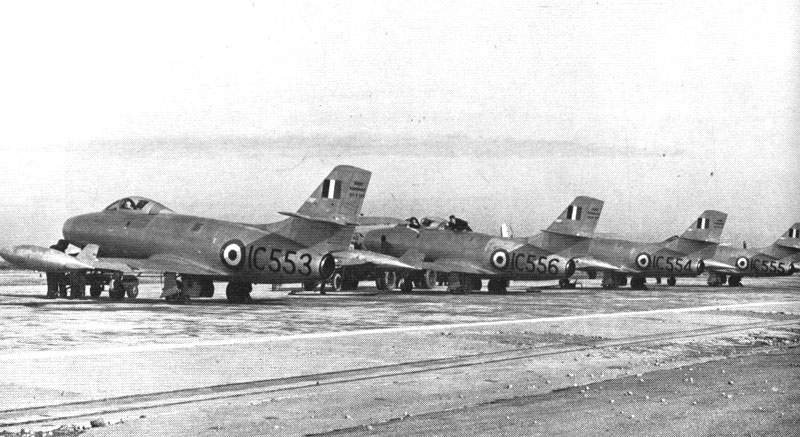
The first-ever ferry of french fighters from France to India were these four Dassault MD450 Ouragan single-seat fighters , Numbers IC553, IC556, IC554 and IC555.
29th July 2020 was the day when the whole country today waited with bated breath on the arrival of the first batch of the Dassault Rafale fighters from France. The country saw press coverage that was unprecedented, and the publicity around their arrival was so much that the District Magistrate in charge of Ambala had to pass special orders under Section 144 preventing people from gathering near the airfield in an attempt to photograph the arriving aircraft. Media channels staked out all possible paths that the aircraft were to arrive over in a bid to provide coverage.
The Rafales in Indian colours had started their journey from the Dassault Aviation Facility in Merignac, France. The ferry is planned in two stages, the first leg was supported by Air to Air Refuelling by the French tankers, and the aircraft will make a stop-over at the Al Dahfra airbase in the United Arab Emirates. The aircraft reached Air Force Station Ambala on 29th July 20, whereupon No.17 Squadron was re-raised on this type. In the context of the ferry, Vishnu Som, Senior Editor at NDTV Television Channel, had made the following tweet, pointing out historical precedence from 67 years ago, when the first four Dassault Ouragan fighters were ferried out by Indian Pilots from Maison de Marce in France to Ambala in India.
India acquired its first jet (Ouragan/Toofani) from @Dassault_OnAir 67 years ago. Today’s Rafales flew to Ambala one stop. Back then, the log-book of Wg Cdr PVS Ram (retd) indicates they flew 12 stops including Karachi which they also bombed 12 years later!@IAF_MCC @vayusena pic.twitter.com/A7CrMIr32K
— Vishnu Som (@VishnuNDTV) July 29, 2020
What went unnoticed initially was that the ferry pilots involved were retracing the flight paths of their predecessors from 67 years prior. In 1953, four dashing Indian Air Force pilots were involved in a similar exercise, ferrying four Dassault Toofani fighters from France to India. Unlike the Rafales which were packed to gills with all kinds of avionics, including GPS, Multi-Function Displays, Auto-Pilot and Navigation Aids, these four had to depend on basic air navigation skills, utilizing Radio-Telephony, the ‘six-pack’ of instruments, and “Eyeball Mark 1”.
Cockpit of the Dassault Rafale pic.twitter.com/8hfOJEDTeC
— Rafale Addict (@RafaleAddict) February 4, 2016
Contrast the vintage layout of the Ouragan cockpit – with dials and switches, no auto-pilot or moving map displays.
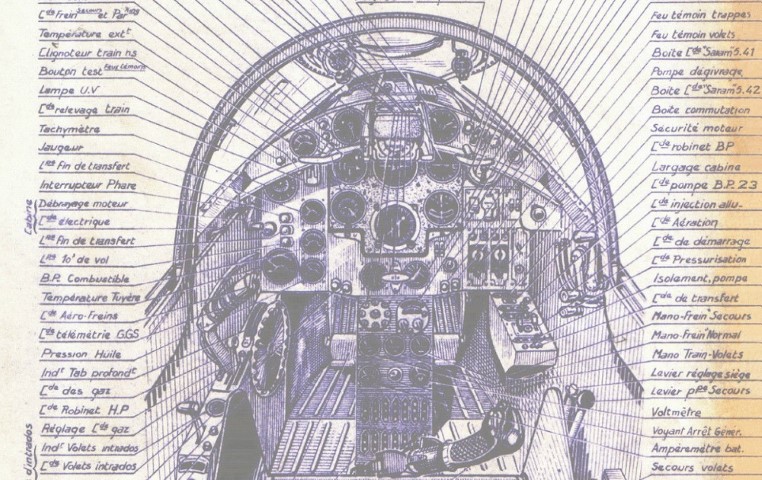
Courtesy: CombatAce.com
The procurement of the Ouragan
The story starts a bit earlier in the 1950s, the primary source of defence equipment to the Indian Air Force has been the United Kingdom. Initial IAF acquisitions centered around the Spitfire, Tempest and Vampire fighters from the UK. India had entered into a license agreement where Hindustan Aircraft Ltd would build the Vampire fighter in India at its factory in Bangalore. Additionally, trainer aircraft like the Prentice were also built under license from the UK. At that time the successive IAF Chiefs were all British Officers on deputation. And Britain was the primary arms supplier to the country.
Around 1950-51, tensions mounted with Pakistan, and the likelihood of operations was considered a possibility. The IAF had noted that due to inexperience, the requisite amount of spare parts for the Vampire fighters was not kept in stock. And there were issues sourcing the supplies at the last moment. The dependence on a single country as the source for aircraft spares became obvious.
In 1952, the Directorate of Plans and Policy started looking at other countries as potential partners. The Directorate (led by Wg Cdr M S Chaturvedi) picked the French Dassault Ouragan (Hurricane in French) fighter-bomber . The Ouragan was a light fighter built around the Rolls-Royce Nene engine and equipped with four 20mm guns, it had flown for the first time on 28 Feb 1949. More prototypes and flying development occurred, and it was only around May 1952, did the type enter into squadron service with the French Air Force.
The Air Chief at that time, Air Marshal Gerald Gibbs was an RAF Officer, and he was opposed to the acquisition. He recommended going with the Gloster Meteor (it was rumoured that he was offered a directorship at Gloster after his retirement). However Gibbs, even though being the chief did not steamroll the recommendation and let the decision to the Government. Once the decision to acquire the Ouragans was taken, the first order for 75 aircraft was placed on 25th June 1953. The first four aircraft were to be handed over in France and flown to India, while the remaining would be sent by sea.
Till then, most of the ferries were made by European pilots, in the pay of the Hawker Aircraft Company. When the first De Havilland Vampire Jet fighters arrived in India, they were all flown in by British pilots. The question was if the Ouragans will be ferried in by French Pilots. The senior Indian officers in Air HQ, AVM Subroto Mukerjee and Air Commodore Aspy Engineers had made up their mind that the Toofanis will be ferried in by Indian Pilots.
Selection of Pilots
Only a few months before, The first Vampire T-55 trainers to be inducted were flown from the UK to India by an Indian contingent. These were two-seat aircraft and all the aircraft were flown with two crew members. The pilots had the benefit of a shared workload in the cockpit, with the second pilot / crew member acting as a navigator. The ferry took place without incident. This time, however, there was no luxury of a second crewmember in the cockpit. The pilots will all have to manually fly the aircraft and navigate in the formation at the same time.
Air Marshal Gibbs, was highly skeptical about the possibility of the ferry being pulled off by Indian pilots, but the senior Indian officers, Air Vice Marshal Subroto Mukerjee, along with Air Commodore Aspy Engineer fully supported the idea. The Director Operations at Air HQ was Gp Capt H S Moolgavkar. One day, he was called in for a meeting with Mukerjee. As he would later recall:
“I was told by AVM Mukerjee, Deputy Chief before AVM Engineer that – ‘go take whoever you like and bring these Ouragons (back). Four should leave France and four should reach India. I don’t want any mishaps on the way, because that will prove the RAF Chief right. The government will not go against him then.” And as if to emphasise on the point “No cock-ups or SNAFUS en route!”.
There was one kink in the plan, the Ouragans was the first type to be equipped with ejection seats in the IAF – and Moolgavkar already had a spinal injury dating back to a Spitfire Crash during the Second World War. The doctors had cautioned him that in case of ejection the injuries can be severe as his spine would be exposed to high G Forces. Moolgavkar had to tell the doctors that he would give in writing that he would be fine flying an ejection seat aircraft. (This obviously would never fly in today’s airforce!). He had his clearance to fly ejection seat equipped aircraft after that.
Moolgavkar then handpicked the pilots who would accompany him for the ferry – they were:
- Sqn Ldr Roshan Suri – 2459 GD(P) A test pilot school graduate from 1951 and commanding officer of No.8 Squadron, which was then operating Vampires at that time.
- Sqn Ldr Suranjan Das – 3175 GD(P) – A test pilot graduate from 1949 from ETPS UK. Previously he had trained in Canada as part of the BCATP.
- Flt Lt P V S Ram – 3084 GD(P) – A Pilot Attack Instructors Course graduate from the Air Armament School in France in 1951. Ram was with No.8 Squadron at that time as well. Ram was previously involved in two bale outs – once from a Spitfire and a second time from a Tempest. He was also one of the few pilots to have type experience on the P-51 Mustang – flown during his time with the AAS in Australia.
All the pilots had some Jet flying experience on the De Havilland Vampire.
Training in France
Moolgavkar and his team went to France in August 1953. Moolgavkar deciding to take a Devon and flew from India to France checking on the transit airfields along the way. One of the airfields identified was Sharjah where a makeshift runway was to be created by spraying crude oil over the sand to make it a semi-hard surface.
At the end of August 1953, the team reached Mont de Marsan where the Center d’Expérimentation Aériennes Militaires, also known as CEAM was located. Conversion on the type started almost immediately. P V S Ram did his first flight on the Ouragon on 21 August 1953, followed by 24 more sorties on the French aircraft over the next one month. The conversion included GCA Practice, formation flights, Quarter Gun Attacks, Aerobatics, Air to Air Combat etc, and was very comprehensive. There were challenges on a few occasions, like when the English speaking Air Traffic Controllers were replaced by French-speaking ones – as Moolgavkar found himself in a quandary trying to do a range test on that particular day and had to scrub the sortie!.
In late September, the Indian Contingent took over the newly delivered Ouragans for the IAF. The four aircraft slated for the IAF bore the tail numbers IC553-556.. Ram was allotted IC556 and he carried out several air tests over the next few days. There was a gap in flying in early October. The Ferry was slated to start on the 15th. (In between Moolgavkar took a detour to do the first supersonic flight by an Indian pilot – but thats another story).
The Ferry:
Without much fanfare, the ferry commenced on October 14th from Mont de Marsan. The first stop being Estres to the east. The support crew and airmen accompanied the formation in a Dakota. Moolgavkar flew IC553, Roshan Suri on IC554, Das on IC555, and P V S Ram on IC556.
The first leg out of France to Tunis was the most challenging one. The flight to Tunis took them over the Mediterranean Sea over a distance of 500 miles – the formation took an hour and forty five minutes to cover the flight over the sea.
Further stops were made at Tripoli (Libya), El Adem (Libya), Cairo (Egypt). At Cairo, they were received by officers of the Royal Egyptian Air Force.
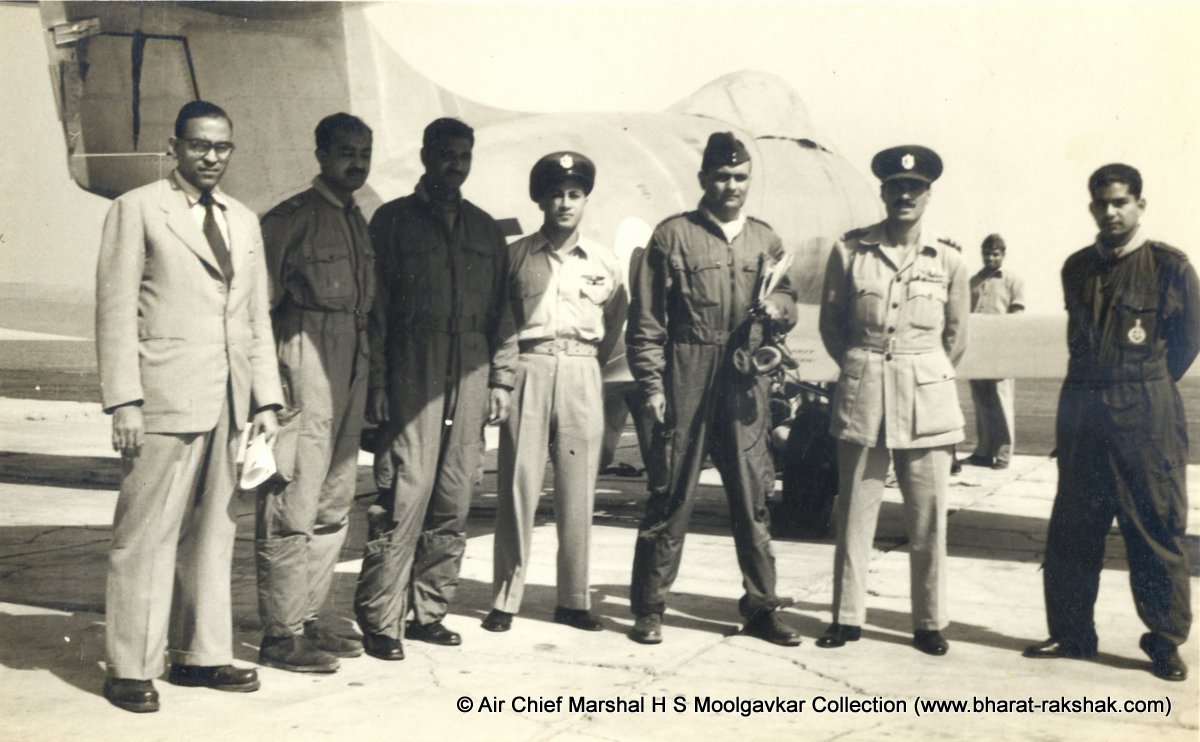
Stopover at Cairo – L to R : Unidentified Indian Official. Sqn Ldr Suranjan Das, Sqn Ldr Roshan Suri, REAF Officer, Gp Capt H S Moolgavkar, REAF Officer, Flt Lt P V S Ram.
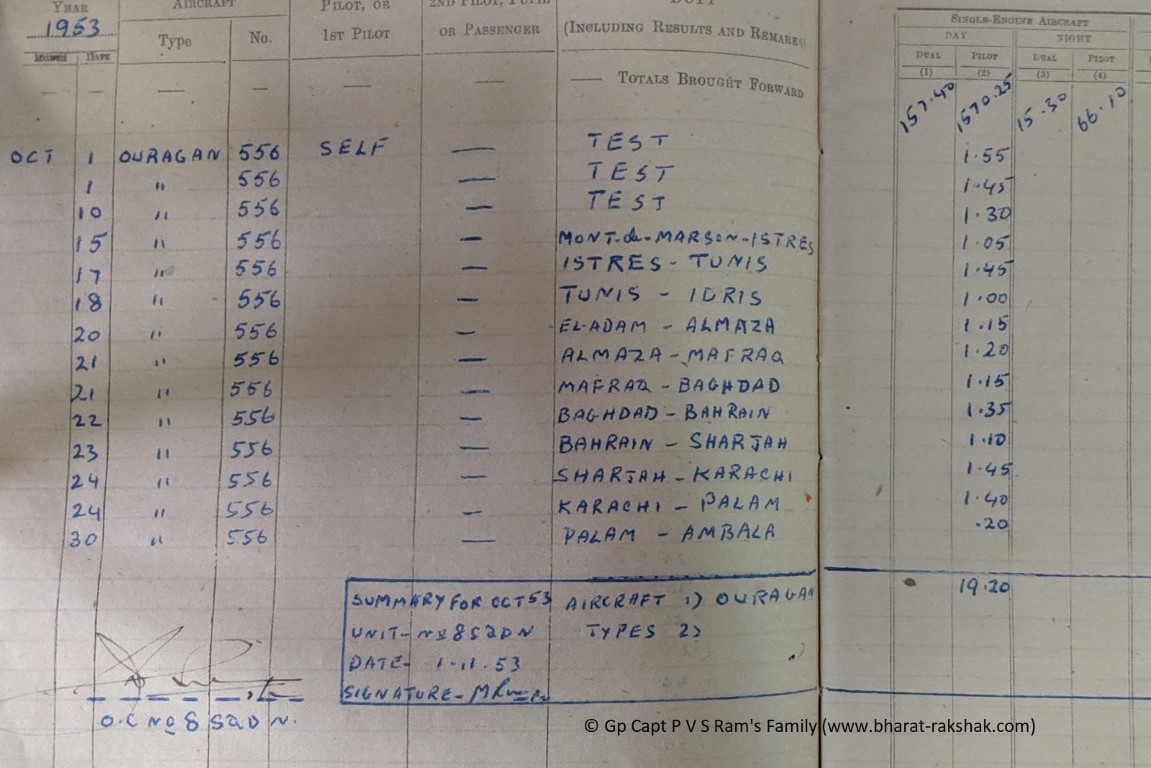
The progress of the Ouragan’s Ferry is much better told through these logbook pages. The above belonging to Wg Cdr P V S Ram. The stopovers between each leg and the duration of each flight clearly marked in these pages. As noted at the top of the page, Ram had accumulated nearly 1800 hours of flying, an unusually high number of hours for someone with just over eight years of commissioned service.
The flight continued via Jordan, Iraq, Bahrain, Sharjah. Now there was only one stop between them and India – that was in Karachi. Throughout these legs, with the exception of the first flights over the Meditteranean, the flights always took place over land, or very close to land. Even the last leg to Karachi was flown close to the coast of Iran and Makran.
For the stopover at Mauripur, the Govt of India had the requisite clearance from the Govt of Pakistan to stage through. A surprise awaited the Indian pilots on landing at Mauripur. They were greeted by Gp Capt Asghar Khan and Wg Cdr Nur Khan, both friends of Moolgavkar. They were very curious about the latest ‘acquisition’ of the IAF and spent time looking over the birds. Moolgavkar himself as curious about the Attacker fighter that was inducted in Pakistan and questions were exchanged between Moolgavkar and and his PAF friends.
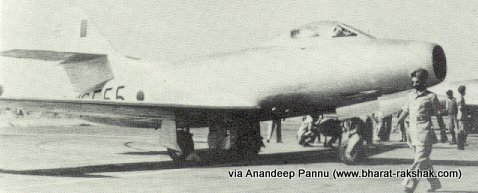
Ouragan IC555 photographed during its stop at Mauripur airfield, Karachi. This was presumably flown by Sqn Ldr Suranjan Das.
The same day that they arrived at Mauripur, after refuelling and rest, the pilots set off for the final leg to Palam. All the four aircraft reached without incident on 24th October.
There was still one final stop. Ambala. The pilots took time off to relax and recoup. Moolgavkar made a familiarisation flight in a Devon to Ambala in between and the final flight to Ambala took place on 30th October 1953.
There was much fanfare at Ambala on the morning of the arrival of the Toofanis, as Wg Cdr V Kondath recalls, Ambala ATC’s VHF R/T went dead, and a signal flare fired from the very pistol set the grass on fire. Not withstanding that drama, the four aircraft landed safely capping a ferry flight of over 5000 miles, 12 stops and 15 days!
The Toofanis (as the Ouragans later came to be called in Indian service) served as the mainstay for another four years till the induction of the Dassault Mystere IVa in 1957, orders for which were placed in 1956. The Mystere was a natural development of the Ouragan, built with swept wings and capable of supersonic flight in a dive. Various prototypes were built, but it was the Mystere IVa version that India ultimately procured and inducted. The Ouragans continued service till the late 60s before their final phasing out around 1967.
Though the aircraft has not been retired for 53 years, there are several ‘survivors’ around the country. Toofani IC554, the second aircraft handed over by the french and the example flown by Sqn Ldr Roshan Suri, survived and is today preserved at the Indian Air Force Museum in Palam.
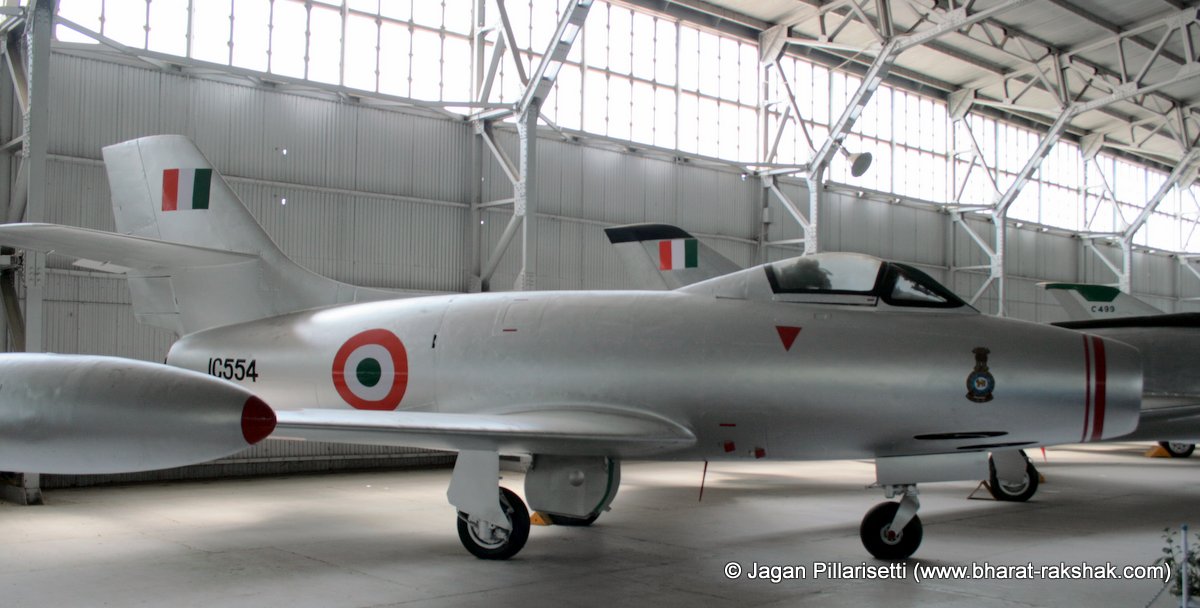
IC554, the second Toofani that formed part of the ferry is preserved at the IAF Museum in Palam. Photographed in 2008.
View all the images:
{gallery}history/1950s/toofanis{/gallery}
Further Reading:
- The history of the MD450 Ouragan in the French Air Force by Baptiste (in French)
- Dassault and the origins of the Ouragan and Mystere by Luc Berger (in French)
- Arrival of Toofanis at Ambala by late Wg Cdr V Kondath
Acknowledgements:
- Late Air Chief Marshal H S Moolgavkar – Interviewed in 2003 by the Author. At that time he had shared various photographs and information from logbook that has been used for this article.
- Mrs Anuradha Teneti, daughter of late Wg Cdr P V S Ram, for sharing the logbook pages as well as providing the impetus to put this article on paper.
- Leading from the Cockpit : A fighter pilot’s story. The biography of Air Chief Marshal H S Moolgavkar. by Ms Jyoti M Rai